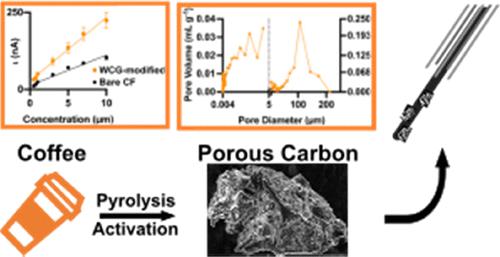Our official English website, www.x-mol.net, welcomes your feedback! (Note: you will need to create a separate account there.)
Waste Coffee Ground-Derived Porous Carbon for Neurochemical Detection
ACS Sensors ( IF 8.9 ) Pub Date : 2024-02-21 , DOI: 10.1021/acssensors.3c02383 Blaise J. Ostertag 1 , Ayah J. Syeed 1 , Alexandra K. Brooke 1 , Kamya D. Lapsley 1 , Evan J. Porshinsky 1 , Ashley E. Ross 1
ACS Sensors ( IF 8.9 ) Pub Date : 2024-02-21 , DOI: 10.1021/acssensors.3c02383 Blaise J. Ostertag 1 , Ayah J. Syeed 1 , Alexandra K. Brooke 1 , Kamya D. Lapsley 1 , Evan J. Porshinsky 1 , Ashley E. Ross 1
Affiliation

|
We present an optimized synthetic method for repurposing coffee waste to create controllable, uniform porous carbon frameworks for biosensor applications to enhance neurotransmitter detection with fast-scan cyclic voltammetry. Harnessing porous carbon structures from biowastes is a common practice for low-cost energy storage applications; however, repurposing biowastes for biosensing applications has not been explored. Waste coffee ground-derived porous carbon was synthesized by chemical activation to form multivoid, hierarchical porous carbon, and this synthesis was specifically optimized for porous uniformity and electrochemical detection. These materials, when modified on carbon-fiber microelectrodes, exhibited high surface roughness and pore distribution, which contributed to significant improvements in electrochemical reversibility and oxidative current for dopamine (3.5 ± 0.4-fold) and other neurochemicals. Capacitive current increases were small, showing evidence of small increases in electroactive surface area. Local trapping of dopamine within the pores led to improved electrochemical reversibility and frequency-independent behavior. Overall, we demonstrate an optimized biowaste-derived porous carbon synthesis for neurotransmitter detection for the first time and show material utility for viable neurotransmitter detection within a tissue matrix. This work supports the notion that controlled surface nanogeometries play a key role in electrochemical detection.
中文翻译:

用于神经化学检测的废弃咖啡渣衍生多孔碳
我们提出了一种优化的合成方法,用于重新利用咖啡废物,为生物传感器应用创建可控、均匀的多孔碳框架,以通过快速扫描循环伏安法增强神经递质检测。利用生物废物中的多孔碳结构是低成本储能应用的常见做法;然而,尚未探索将生物废物重新用于生物传感应用。通过化学活化合成废咖啡渣衍生的多孔碳,形成多孔、分级多孔碳,并且该合成针对多孔均匀性和电化学检测进行了专门优化。这些材料在碳纤维微电极上进行修饰后,表现出高表面粗糙度和孔隙分布,这有助于显着改善多巴胺(3.5±0.4倍)和其他神经化学物质的电化学可逆性和氧化电流。电容电流增加很小,表明电活性表面积有小幅增加。多巴胺在孔内的局部捕获导致电化学可逆性和频率无关行为的改善。总的来说,我们首次展示了一种用于神经递质检测的优化的生物废物衍生的多孔碳合成,并展示了在组织基质内可行的神经递质检测的材料效用。这项工作支持了受控表面纳米几何形状在电化学检测中发挥关键作用的观点。
更新日期:2024-02-21
中文翻译:

用于神经化学检测的废弃咖啡渣衍生多孔碳
我们提出了一种优化的合成方法,用于重新利用咖啡废物,为生物传感器应用创建可控、均匀的多孔碳框架,以通过快速扫描循环伏安法增强神经递质检测。利用生物废物中的多孔碳结构是低成本储能应用的常见做法;然而,尚未探索将生物废物重新用于生物传感应用。通过化学活化合成废咖啡渣衍生的多孔碳,形成多孔、分级多孔碳,并且该合成针对多孔均匀性和电化学检测进行了专门优化。这些材料在碳纤维微电极上进行修饰后,表现出高表面粗糙度和孔隙分布,这有助于显着改善多巴胺(3.5±0.4倍)和其他神经化学物质的电化学可逆性和氧化电流。电容电流增加很小,表明电活性表面积有小幅增加。多巴胺在孔内的局部捕获导致电化学可逆性和频率无关行为的改善。总的来说,我们首次展示了一种用于神经递质检测的优化的生物废物衍生的多孔碳合成,并展示了在组织基质内可行的神经递质检测的材料效用。这项工作支持了受控表面纳米几何形状在电化学检测中发挥关键作用的观点。



























 京公网安备 11010802027423号
京公网安备 11010802027423号